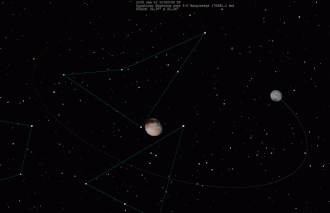Charon (moon)






Charon is the largest moon of Pluto, discovered in 1978 by astronomer James Christy. It is named after the ferryman of the dead in Greek mythology, reflecting its association with the underworld figure Pluto. Charon and Pluto are often referred to as a binary system because the barycenter of their orbits does not reside within either body. Instead, it lies in the space between them, making their orbit around each other unique among the planets and their moons in the Solar System.
Discovery and Naming[edit]
The discovery of Charon was a significant event in the study of the outer Solar System. Before its discovery, little was known about Pluto, and the finding of a moon provided astronomers with new avenues to explore Pluto's mass and composition. The name "Charon" was officially adopted by the International Astronomical Union (IAU) in 1985, following the tradition of naming celestial bodies after mythological figures.
Physical Characteristics[edit]
Charon is about half the size of Pluto, making it one of the largest moons in the Solar System relative to its parent planet. It has a diameter of approximately 1,212 kilometers. Charon's surface is composed primarily of water ice, with regions of frozen ammonia and other volatiles. The moon exhibits a diverse range of terrains, including canyons, craters, and plains.
One of the most striking features of Charon is a large canyon system that rivals the Grand Canyon in depth and exceeds it in length. This feature suggests a complex geological history that may include past tectonic activity.
Orbit and Rotation[edit]
Charon orbits Pluto at a distance of about 19,600 kilometers, with an orbital period of about 6.4 Earth days. Both Charon and Pluto are tidally locked, meaning they always show the same face to each other. This synchronous orbit is a result of gravitational forces that have synchronized their rotation periods.
Exploration[edit]
The most detailed exploration of Charon came from the New Horizons mission, which flew by the Pluto-Charon system in July 2015. The spacecraft provided high-resolution images and data on Charon's surface composition and topography, revealing a young surface that suggests geological activity in the moon's recent past.
Significance[edit]
The study of Charon, alongside Pluto, provides valuable insights into the processes that shape the icy bodies in the Kuiper Belt and beyond. Understanding Charon's geology and composition helps astronomers piece together the history of the outer Solar System and the formation of similar binary systems.
See Also[edit]
Ad. Transform your life with W8MD's Budget GLP-1 injections from $75


W8MD offers a medical weight loss program to lose weight in Philadelphia. Our physician-supervised medical weight loss provides:
- Weight loss injections in NYC (generic and brand names):
- Zepbound / Mounjaro, Wegovy / Ozempic, Saxenda
- Most insurances accepted or discounted self-pay rates. We will obtain insurance prior authorizations if needed.
- Generic GLP1 weight loss injections from $75 for the starting dose.
- Also offer prescription weight loss medications including Phentermine, Qsymia, Diethylpropion, Contrave etc.
NYC weight loss doctor appointmentsNYC weight loss doctor appointments
Start your NYC weight loss journey today at our NYC medical weight loss and Philadelphia medical weight loss clinics.
- Call 718-946-5500 to lose weight in NYC or for medical weight loss in Philadelphia 215-676-2334.
- Tags:NYC medical weight loss, Philadelphia lose weight Zepbound NYC, Budget GLP1 weight loss injections, Wegovy Philadelphia, Wegovy NYC, Philadelphia medical weight loss, Brookly weight loss and Wegovy NYC
|
WikiMD's Wellness Encyclopedia |
| Let Food Be Thy Medicine Medicine Thy Food - Hippocrates |
Medical Disclaimer: WikiMD is not a substitute for professional medical advice. The information on WikiMD is provided as an information resource only, may be incorrect, outdated or misleading, and is not to be used or relied on for any diagnostic or treatment purposes. Please consult your health care provider before making any healthcare decisions or for guidance about a specific medical condition. WikiMD expressly disclaims responsibility, and shall have no liability, for any damages, loss, injury, or liability whatsoever suffered as a result of your reliance on the information contained in this site. By visiting this site you agree to the foregoing terms and conditions, which may from time to time be changed or supplemented by WikiMD. If you do not agree to the foregoing terms and conditions, you should not enter or use this site. See full disclaimer.
Credits:Most images are courtesy of Wikimedia commons, and templates, categories Wikipedia, licensed under CC BY SA or similar.
Translate this page: - East Asian
中文,
日本,
한국어,
South Asian
हिन्दी,
தமிழ்,
తెలుగు,
Urdu,
ಕನ್ನಡ,
Southeast Asian
Indonesian,
Vietnamese,
Thai,
မြန်မာဘာသာ,
বাংলা
European
español,
Deutsch,
français,
Greek,
português do Brasil,
polski,
română,
русский,
Nederlands,
norsk,
svenska,
suomi,
Italian
Middle Eastern & African
عربى,
Turkish,
Persian,
Hebrew,
Afrikaans,
isiZulu,
Kiswahili,
Other
Bulgarian,
Hungarian,
Czech,
Swedish,
മലയാളം,
मराठी,
ਪੰਜਾਬੀ,
ગુજરાતી,
Portuguese,
Ukrainian
